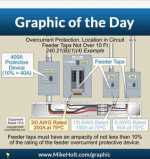In another thread ( https://forums.mikeholt.com/threads/splicing-tap.2569512/#post-2775506 ) there was a tap which appeared to be a #10 off what is assumed to be a 400 amp Over-current device.
Question: Would this meet the tap rule ? I applying the 10% rule are we allowed to use the 90° rating of the conductor. The downstream OCP device might limit the actual current to 20 or 30 amps but in order to meet the 10% restriction the 90° rating would need to be employeed,
Question: Would this meet the tap rule ? I applying the 10% rule are we allowed to use the 90° rating of the conductor. The downstream OCP device might limit the actual current to 20 or 30 amps but in order to meet the 10% restriction the 90° rating would need to be employeed,


